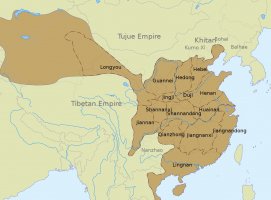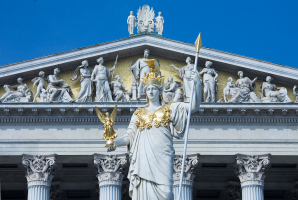Top 14 Astonishing Ancient Chinese Myths
There are countless depictions of gods and goddesses, legendary creatures, historical figures, dragons, and unicorns in China, a land of mystery and ... read more...enchantment. Chinese mythology have been influenced by the numerous battles, religions, and ideologies that China has experienced throughout its history. There is frequently no clear dividing line between earth and heaven, history and storytelling, the past and the present in many of the well-known Chinese tales. China is a patchwork of various traditions and philosophies. And when we discuss the historical mythology of China, we must keep this in mind. The struggle of simple people against enormous affliction is a recurrent motif in most Chinese mythology, despite their diverse themes and variances. Here is a list of well-known myths from ancient China.
-
There are numerous tales of the magnificent kings of ancient China's oldest mythology, but no creation myths. The most accurate Chinese creation myth is undoubtedly the tale of Pangu (also known as Panku). In the creation myths of the Chinese Taoists, Pangu is the main character.
Pangu is a well-known character in Chinese creation mythology. The Zhuang people still sing a traditional song about Pangu creating Heaven and Earth. The origins of the Pangu myth have long been debated. Many believe it originated with Xu Zheng, a Chinese author from the third century AD, as he was the first to record it; others believe it originated in the mythologies of the Miao or Yao people of southern China, while others see a parallel to ancient Hindu creation mythology.
The Pangu myth goes as follows: At first, the universe was nothing but chaos, and the heavens and the earth were mixed together - often compared to a large, black egg. The Yin and Yang balanced as Pangu developed throughout the 18,000 years that he slept after being born inside of this egg. He discovered he was stuck inside it when he opened his eyes. He separated the Yin and Yang by breaking the egg and starting to push the pieces apart. The sky above him appeared in the upper half of the shell, and the earth appeared in the lower half. The longer he kept them apart, the thicker they grew and the taller he grew, pushing them apart by exactly 10 feet per day. Versions start to change here. Some say a turtle, a qilin, a phoenix, and a dragon helped him with this task. Pangu died after another 18,000 years, his body forming various parts of the earth and the parasites on his body forming humans. Another version claims that he created the earth with a chisel and hammer, while another claims that humans were created by a goddess who later inhabited the earth.
Pangu was the first supreme being and the creator of the heavens and the Earth, according to this myth. He is usually depicted as a dwarf, despite the fact that he was a giant, with horns fixed atop his head and either a chisel, a hammer, or an egg in his hand. Other stories describe a Pangu as a creature from heaven with the head of a dog and the body of a man, accrediting Pangu as the father of mankind, while another version claims he molded men from clay.
The similarities between this story and other myths make it interesting. Scientifically speaking, one common idea that represents the cosmos prior to the Big Bang is the cosmic egg. Although this may seem like a pretty crude way to describe such an incident at first, one cannot help but note how incredibly insightful it is. How could different people who didn't have access to technology or understanding of the cosmos as we know it now explain things so precisely? Were they somehow made aware of this information?
Another intriguing aspect of the story is one of the more enigmatic. According to some versions of the Pangu creation myth, the giant was assisted by four mythical beasts. Let us take a quick look at each of these beasts. The turtle, for starters: the Chinese were not the only ones to include it in their creation myth; various world myths, creation and otherwise, include the turtle for its strength and immortality. The qilin, though native to Asian mythology, is said to resemble a dragon. Dragons are central to Asian mythology though they can be found all over the world as bearers of wisdom and a symbol of power, and they are also linked to the succession of the early emperors. Finally, the phoenix has long been associated with rebirth. Over the years, there has been much speculation about how so many cultures, spread over vast distances, came to utilize the same symbolism and represent similar events.

Pangu - Wikipedia 
Ancient Origins -
Nuwa (also known as Nugua), the goddess of humanity, is one of the most well-known figures in ancient Chinese mythology. According to legend, Nuwa created humanity and repaired the pillar of heaven and the broken corners of the earth that Gong Gong had destroyed in a fit of rage.
The idea that people were made of clay, however, is a much more widely held misconception. As the one who starts the creation process, Nuwa is the main figure in this tale, with Fuxi typically acting as her assistant. According to the tale, lonely Nuwa decided to make mud monsters to keep her company.
One version of the tale claims that Nuwa produced a different animal each day for six days in a row, including the chicken, dog, boar, sheep, cow, and horse. Humans were the seventh day's creation by her. The festival of "Human Day," which occurs on the seventh day of the Chinese New Year, is based on this myth.Nuwa's creation of human beings is also used to explain (and possibly justify) the existence of a hierarchy in Chinese society. In one version of the myth, Nuwa began creating humans by hand-forming clay figures. Her hands, however, began to hurt after a while. As a result, she dipped a rope in mud and swung it around her head. As a result, sticky mud blobs formed around her. According to Chinese legend, the clay figures created by Nuwa's hands became the nobility, while the blobs of mud became the common people.
The tale states that a fierce conflict took place between the fire and water gods Gonggong and Zhurong. Gonggong was infuriated and hit his head on the fabled Buzhou Mountain when he realized he was losing the battle. Being one of the four pillars that supported the skies, this mountain was not your typical mountain. Gonggong's action caused the mountain to crumble and torn a hole in the sky. This resulted in the earth shaking and splitting open as half the sky fell on it. Furious animals appeared from the earth, forests were burned, and the world was flooded. A large number of victims were burned, drowned, and eaten.
Nuwa was heartbroken when she saw her children in pain and immediately took action to save them. First, she melted five different colored stones. Nuwa patched the sky with the molten mixture. She then approached Ao, the sky turtle, and asked for his assistance. The turtle agreed to help Nuwa and agreed to let her cut off its four legs. These were used to replace the pillar that Gonggong had previously destroyed. Following that, Nuwa captured and killed a dragon, which scared the other creatures that emerged from the earth, preventing them from attacking humans further. Finally, she set fire to a large number of reeds and used the ashes to stop the floods. According to one version of the story, the work sapped Nuwa's strength, and she died of exhaustion after lying down to rest. In another version, Nuwa realized she didn't have enough stone to cover the sky patch. As a result, she chose to sacrifice herself and fill the remaining void with her own body.
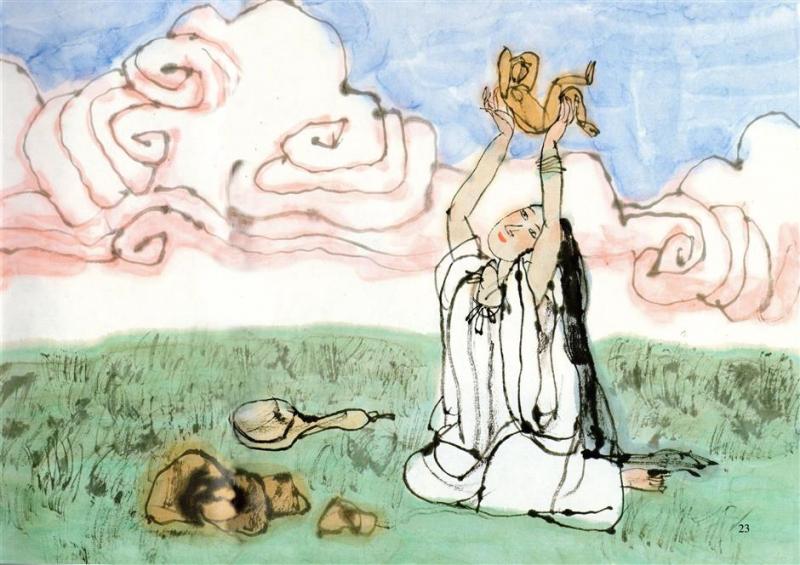
Shanghai Daily 
Mythopedia -
The ten legendary rulers or gods who led humans through their prehistoric beginnings are the subject of the oldest mythologies (around 3000 to 2197 BC). They were semi-divine, semi-human demigods who dwelt among the populace and imparted to them the virtues of civilization.
Fushi was the magical period's first ruler. Many scholars believe that his story is based on the life of an actual monarch who reigned between 2953 and 2736 BC. Fushi has been depicted as a beloved figure who taught early humans survival skills in all of these mythological stories.
He taught people how to use fire, cook, write, and a variety of other skills such as hunting, fishing, and fortune-telling. Some myths depict Fushi as having a human body, while others depict him as having a human head and a snake body. In many stories, he is regarded as Nuwa's husband, and the two are credited with founding civilization.
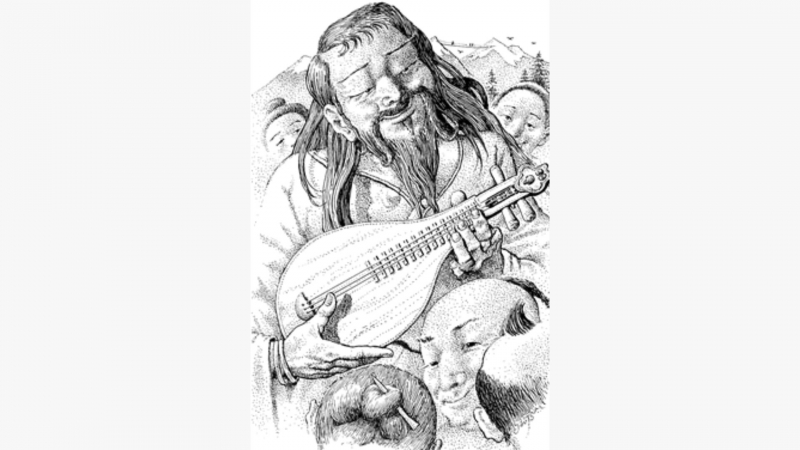
Age Mythology Stories 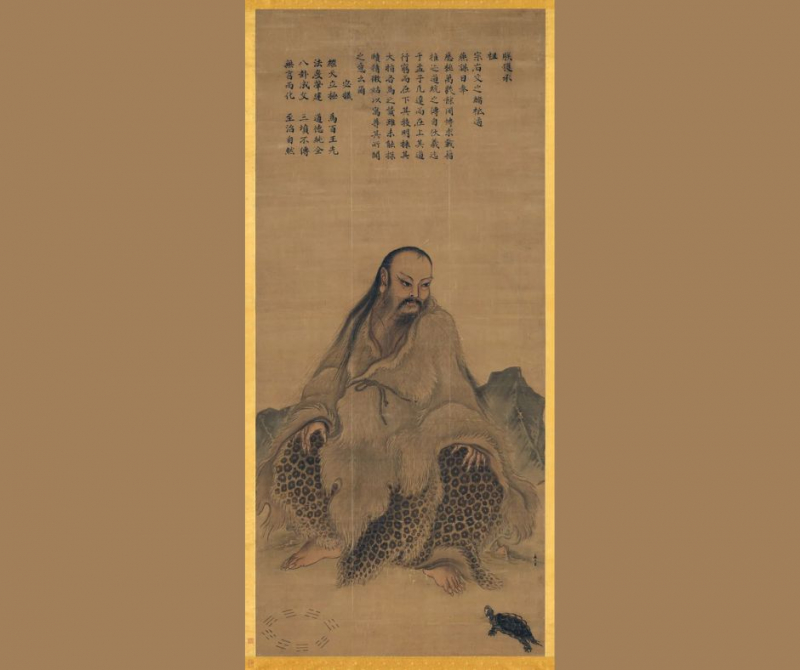
Fu Xi, painting on silk - National Palace Museum, Taipei -
One of the figures in ancient Chinese mythology who is commonly mentioned is the Chinese water god Gong Gong (also known as Kang Hui). In legends, he is pictured with red hair and a serpent's tail.
Various mythical sources attribute the cause of devastating floods to Gong Gong. Soon after the birth of humans, he fought to take control of the planet. Zhurong, the fire god, governed the universe happily before Gong. Gong sought to increase the amount of water in the cosmos, which is currently seven-tenths water to three-tenths dry land, in order to increase its amount when he became the ruler. He then engaged in a vicious power fight with Zhurong and brought down torrential rains, almost wiping out the entire planet.
Nuwa, the creator of people, appears in this myth to counteract the destructive forces of Gong and Zhurong. Gong is frequently regarded as an ancient destroyer god and is blamed for a variety of cosmic disasters. Gong Gong is either killed or exiled, according to all accounts.

Pinterest Api Ngo - That Chinese History Guy -
Many ancient Chinese mythologies depict gods assisting the people. The Grand Archer Yi, on the other hand, is one of the rare mortals who has aided the gods. His excellent skill in archery distinguishes him. Hou Yi is thought to have lived between the years 2436 and 2255 BC.
Grand Archer Yi, a humanitarian, proceeded on his mission to protect common people from evil activities after destroying the four terrible creatures as ordered by the God of Heaven. Yi made the decision to punish Fengbo (the God of Wind), who had brought about all the mayhem after he one day saw thousands of homes devastated by a gale. Just as Fengbo attempted to blast him away, Yi shot him in the left knee. The sky became clear as Fengbo departed the scene in agony.
Yi's next mission took him to the north, where there was a river god named Jiuying. Jiuying was a nine-headed bird that flipped boats and flooded fields. Yi swam across the flood and into the raging river. Jiuying charged in all directions with its nine razor-sharp beaks, laughing in a crazy baby voice. But Yi remained calm and killed Jiuying with direct hits to the nine heads. Yi then started out for the Yellow River, which was accompanied by rolling mountains of waves. He noticed Hebo (the River God) frolicking in the waves and spreading havoc, so he shot him in the left eye as a warning. After being wounded, Hebo retreated, and the water calmed down.
Over the East Sea, in the distance, lay a valley known as Yanggu. There was a massive Fusang tree where ten of God's children lived. They had three feet each and were golden crows. In other words, they were the suns or sun spirits. They frequently took baths in the valley's Xianchi Pond and took breaks on the Fusang tree's limbs. One of the suns would rise in the sky each day, travel from east to west, and provide warmth and light before retiring to the tree for the day. Turns were taken by each sun. However, one day, as one sun left for duty, the other nine brothers decided to accompany him for fun. Because all ten suns shined at the same time, the earth was burnt, crops withered, and cattle died, while fish and turtles were exposed on a dry river bed.
Emperor Yao gave him some comfort when he asked for advice, assuring him that "the way of heaven corresponds with the will of people." Yi headed off and reached a mountain top, where he told the suns that they had had enough of playing around and that they should stop messing around and return home.
The suns were taken aback that someone dared to punish God's offspring. With all their flames and heat, they flushed and ran for Yi. But Yi was prepared, and he fitted a magical arrow to his bow, warning the suns that if they did not return home, he would shoot them down. The suns disregarded him and set fire to the plants surrounding him. Yi replied quickly, firing three arrows at the suns. His accuracy was flawless, resulting in three fireballs exploding in the sky and three golden crows falling into the sea. The suns were terrified and flew into the sky. Yi didn't stop and filmed two more sundowns. The remaining suns were enraged and attempted to burn Yi.
But Yi maintained his composure and pulled out a quiver of arrows. Four more suns erupted and dropped from the sky in all directions as Yi positioned himself on one knee and fired. The sea attempted to catch the falling golden crows after being startled. Yi was about to fire again when he heard the crowd pleading to stop shooting immediately. Yi shivered as she realized there was only one sun remaining in the sky. The last arrow was placed in his bag as he halted.
God then commanded the suns' goddess mother, Xihe, to mount six dragons and escort the single remaining sun on daily patrols of the sky. The ground cooled and the river resumed its flow. Yi said Yao farewell and traveled eastward, the cheers of the people ringing in his ears.

Yi shot Hebo in the left eye and Hebo retreated. The river calmed down.- Age Mythology Stories 
The suns tried to burn Yi but Yi remained calm and took out a bundle of arrows. - Age Mythology Stories -
Chinese myths originating between 2205 and 2197 BC serve as the foundation for the mythology of Yu the Great.
Yu the Great, like many demigods in antiquity, had the ability to alter his shape as needed. He had the ability to change into a person, a dragon, or a bear. Yu is credited with being the first to transmit his position as ruler to his offspring, founding the Xia dynasty, which is regarded as the first dynasty.
The Xia dynasty, however, remains a myth due to a lack of archaeological evidence. One of Yu's many legends tells of his extraordinary birth, when a man named Gun was told he could control a great flood. To dam the water, he stole a piece of magical soil from heaven.
The Shangdi, or supreme deity, was enraged with him and gave the order for his killing. Three years later, Gun's miraculously preserved body was cut open, and a son was born. He was Da Yu, and he was the one who, after many years of laborious dredging with the aid of the dragons, gave outlets to the sea, making the ground suitable for human habitation.
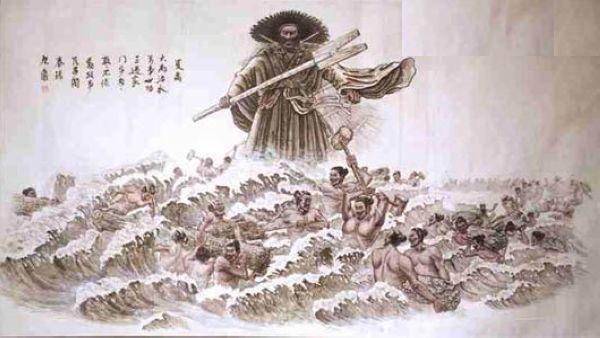
Amazing Cultures 
Ancient History Lists -
The Chinese goddess of the moon, Chang-O (or Chang'e), is the focus of a number of myths.
The elixir of life, a kind emperor, the moon, Hou Yi the archer, and other characters are central to the moon goddess story.
This well-known and fascinating tale of Chang-O transports you to a long-ago era when the ten sons of the Jade Emperor were changed into ten suns. The existence of mankind was in danger as the 10 suns soared to the heavens and burnt the planet. Nine of these suns were taken out by the archer Yi, leaving only one.
Yi was then given the elixir of immortality. When Yi was out hunting one day, his apprentice Feng Meng broke into his home and attempted to steal the elixir from Yi's wife, Chang'e. Chang'e, on the other hand, refused to give the elixir to Feng Meng and drank it all herself. She became weightless as she consumed it, flew upwards towards the heavens, and stayed on the moon as a refugee.

Chang'e - Wikipedia 
Pinterest -
China has its own unique unicorn. It is a well-known truth that unicorns have traveled to all parts of the world, and numerous cultures have some sort of connection to them. You may not be surprised to find that there is a Chinese unicorn, also known as the Qilin, as their hooves have touched down on various different continents. One of the four noble animals of Eastern Asia is the Chinese unicorn known as Qilin. The other three are the phoenix, dragon, and tortoise. If you ever have the chance to travel to China, you could be fortunate enough to see one in this stunning nation.
The Qilin is thought to have first appeared in the garden of the fabled Huangdi, the Yellow Emperor of China, in 2697 BC. The gentlest creatures on Earth, qilins don't hurt animals or birds. In this way, they contrast with the early European unicorns, which were still seen as noble and primarily kind creatures while being fearsome and strong.
The Qilin is frequently shown as being wary of walking on the grass out of concern that it would harm delicate flora or insect life. It summons clouds or water fountains and rides on them to get from place to place instead of letting its hooves touch the ground.The Qilin has an extremely odd appearance and bears little resemblance to the unicorn found in Europe. Although there are some subtle variations, it is typically shown as a four-legged monster. It has a magnificent, gem-encrusted body with horse hooves at the ends of its legs and resembles a Chinese dragon in some aspects. It does appear to have a single horn in the middle of its forehead in many descriptions, which is perhaps one of the causes for its first connection to the European unicorn. However, it is commonly portrayed with two horns, and occasionally they seem like a deer's antlers.
Qilins were frequently associated with the birth of famous leaders or prominent persons, such as the 6th century BC scholar Confucius. This was announced by a Qilin appearing to his future mother and coughing up a jade tablet that predicted his birth. When the same sage was hurt by a charioteer, a Qilin was claimed to have foreseen his death.
Only those with a pure soul and the desire to achieve greatness will encounter qilins, and their existence was a sign of luck and favor. Many people believed that they would only show up during the rule of an exceptional leader. Similar to the European unicorns, who would only let virgins or, in some tales, those of excellent reputation approach them, they are associated with good people.
Qilins appear to be a more strong, more attractive, and more fascinating creature in Chinese culture than the European unicorn. They share many of the same traits but to extremes, such as their gentleness in not even hurting the grass. In Chinese beliefs, they appear to have attained almost god-like status, and their symbolism is extremely important to Chinese history and culture.
It is anticipated that as we all work to be more inclusive and aware of cultures different than our own, more people would come to know and respect Qilins. The Qilins allow us to observe one of the Western world's most beloved mythological animals from a new perspective.
An artistic representation of the Chinese unicorn, the Qilin - Unicorn Yard 
Statue of the Qilin - Beijing Summer Palace -
Monkey King, also known to Chinese old and young as Xi You Ji (Journey to the West), is a well-known classical Chinese tale from four hundred years ago. Monkey King is based on the historical story of a great Chinese Tang Dynasty monk named Xuan Zang (602-664). He arrived on foot in what is now India, the birthplace of Buddhism, after a decade of difficulties and tribulations. He was looking for authentic Buddhist holy scriptures. When Xuan Zang returned, he translated the Sutras into Chinese, making a significant contribution to the growth of Buddhism in China.
With Chinese fables, fairy tales, folklore, superstitions, common beliefs, monster stories, and whatever else the author could uncover in the Taoist, Buddhist, and Chinese popular faiths, Monkey King is an allegorical depiction of the journey. While most reviewers concur that the protagonist symbolizes what the author sought to express to his readers - a rebellious attitude against the then-untouchable feudal rulers - average readers are attracted by the skill and wisdom of the Monkey King.
The monkey is indeed defiant. According to legend, he was born from a rock and fertilized by the favor of Heaven and Earth. He learned all of the magic skills and gongfu from an immortal Taoist teacher, and he is highly brilliant. He may now morph himself into 72 various pictures, such as a tree, a bird, a beast of prey, or an insect, and sneak into an enemy's body to battle him or her from within. He can fly 108,000 miles in a single somersault using clouds as a vehicle.
In defiance of the only authority over the heavens, seas, earth, and subterranean realm, he claims to be The King. That act of grave treason, combined with protests from the masters of the four seas and Hell, brings the heavenly army's merciless scourge. In truth, the monkey has fought his way into the ocean and taken the Dragon King's greatest treasure: a massive gold-banded iron rod used as a water ballast. The iron rod, which can grow and contract at will, becomes the monkey's favorite weapon in his later exploits. The monkey stormed into hell and threatened the Hadean monarch into sparing his and his followers' mortal lives so that they may all experience eternity. This was the first time the power of the monkey was put to the test.
The celestial army has suffered countless humiliating defeats after numerous clashes with the courageous Monkey King. The celestial monarch only needs to give the dove side a chance to try their conciliatory technique of bestowing an official title in heaven with minimal authority on the monkey. When he realizes he is nothing more than a laughingstock, the infuriated monkey revolts, fighting his way back to earth to reclaim his rightful place as The King.
Finally, the heavenly army succeeds to capture the just about unstoppable monkey with the aid of all the god warriors and their various skills. He has been given the death penalty. However, every execution strategy fails. The monkey blunts numerous swords that are thrust upon him because of his bronze head and iron shoulders. The emperor orders that he be burned alive in the furnace where his Taoist minister Tai Shang Lao Jun refines his immortality tablets as a final option. The flames and smoke therein didn't kill the monkey; instead, they enhanced his vision, enabling him to see through things that others cannot. He battles his way back down to earth.
At his wits' end, the celestial ruler seeks assistance from Buddha. Buddha imprisons the monkey beneath Wu Zhi Shan, a massive mountain (The Mount of Five Fingers). The tenacious monkey withstands immense weight and pressure. Five hundred years later, the Tang Monk, Xuan Zang, whom we mentioned at the beginning of the story, comes to his aid.
Buddha has made arrangements for Monkey King to serve as the monk's escort in his position as his student in order to ensure that the monk can travel to the West in order to obtain the Sutras. Two additional disciples soon join them on their journey to the west, both at the Buddha's command. One is the amusing and brave pig that a drunken heavenly general transgressed for attacking a fairy, and the other is a sea monster that was once a celestial general but is now exiled for a misdemeanor.
The party of four was bolstered by a horse, an incarnation of a dragon's son, as they embarked on a stormy voyage to the West -a journey packed with acts and adventures that demonstrated the power of the monks' students, particularly Monkey King.

Sun Wukong – Mythopedia 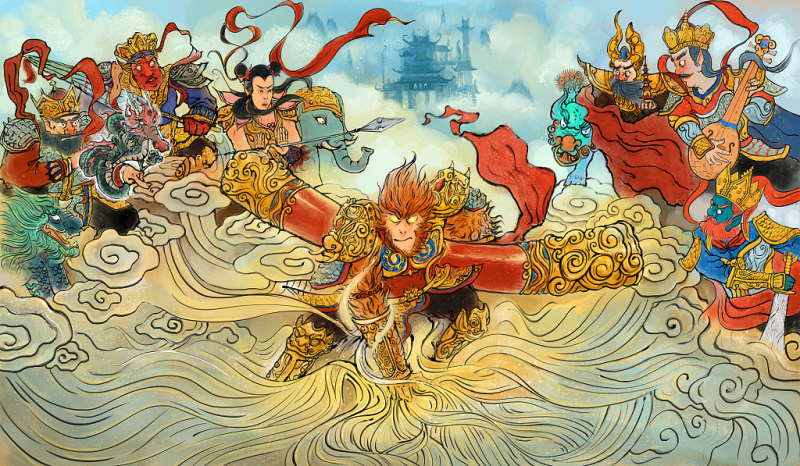
CGTN -
The goddess of kindness and compassion Kwan Yin is the subject of most of the pilgrimage mythology. She is typically seen cradling a baby, wearing all white, and sitting on a lotus in myths.
Her own father was said to have murdered her. She came to hell reciting religious literature, and the king of hell was furious. He returned her to the living world, where she received spiritual insights from Buddha and was later granted immortality.
The Kwan Yin temple, located at the peak of Wondrous Peak, has historically drawn a large number of pilgrims. The Pilgrimage Mythology also discusses how Buddhism came to China and prospered there.
According to legend, The Monkey King converted to Buddhism but continued to use Taoist knowledge and techniques to fight evil.
Ancient History Lists 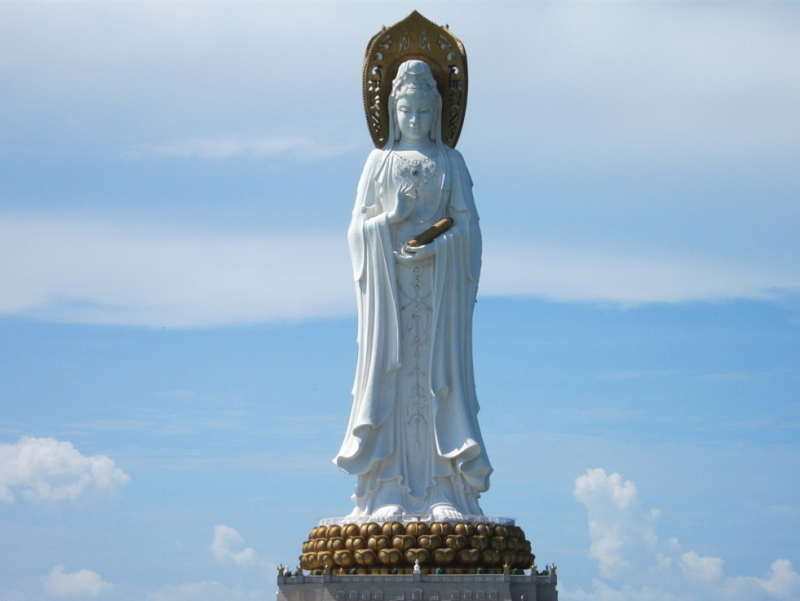
Sana Ako si Ricky Lee! - WordPress.com -
Do you adore Chinese New Year events that allow you to usher in a fresh start? Around the world, people gather with their loved ones to celebrate, praying for good days to come. The decorations and firecrackers are the two main components of Chinese New Year celebrations. But there is a myth associated with this custom.
Fear and myth gave birth to Chinese New Year celebrations. Legend told of the ferocious beast Nian (also the Chinese term for "year"), who emerged at the end of each year and attacked and killed villagers. To scare the beast away, loud noises and flashing lights were deployed, and the Chinese New Year celebrations were formed. Today, the 15-day New Year celebrations are accompanied by a week of vacation in China's major cities. The main celebration happens on the eve of the festival, similar to the Western New Year (January 1st). Fireworks displays are held throughout the city at the start of the new year.
In addition to New Year's Eve, there are other significant days throughout the 15-day Chinese New Year Festival, such as Jie Cai Ceng - Welcoming the Gods of Wealth and Prosperity and Yuan Xiao Jie - Festival of Lanterns. The gods of prosperity are said to descend from the heavens on the fifth day of the new year. Businesses frequently take part in the lighting of firecrackers because they think doing so will bring them luck and prosperity for their enterprise. The Festival of Lanterns, which takes place on the fifteenth day of the New Year, concludes the festivities for the Chinese New Year. All different kinds of lanterns are lighted up in the streets, and poetry and riddles are frequently created for amusement.
The red envelopes packed with money, known as "hong bao" in Mandarin, are traditionally only handed to children or unmarried adults without a job. Even if you're unmarried, working, and earning money, you must still donate the hong bao money to the younger generation. In Chinese culture, the color red represents good luck/fortune and happiness/abundance and is frequently worn or utilized for decoration in other ceremonies. The dragon appears in many Chinese cultural festivities because the Chinese believe they are descended from mythical creatures. On the fifth day of the New Year, when many people must return to work, dancing dragons will perform in front of the office building. They might also have a lot of dancing dragon performances on the fifteenth day of the New Year (Yuan Xiao Jie). The dragon is a symbol of wealth, fortune, and luck.

China Highlights 
WOFS.com -
The story of the Cowherd and the Weaver Girl has its origins in Chinese folklore. While the folktale has various variations, the core of the story focuses on the annual union of two lovers. The narrative starts with seven fairy sisters living in paradise. They traveled to the mortal world one day after getting permission from the Goddess of Heaven. They chose to take their time to complete the journey because they had received permission from the Goddess after many denials. When they arrived in the mortal realm, they decided to take a bath in a lake near the cow herder's house. They laughed, splashed in the water, and loved their time together. However, the noises made the cow herder awaken from his nap and get up to investigate the disturbance. He could see the fairies swimming as he got closer to the lake.
He stole their garments and waited to see what would happen, encouraged by his naughty companion the ox. Zhinu, the youngest and most attractive of the fairy sisters, was chosen to collect their garments. She agreed to do so, but after Niulang saw her, she agreed to his marriage proposal. She was a beautiful wife, and Niulang was a decent and caring husband. They had two children and lived peacefully on Niulang's farm. The other six fairies, who were barred from marrying mortal men, worried about their sister after spending a lot of time in the mortal world. The fairies kept it a secret because they did not want Zhinu's marriage to the mortal cow herder to be revealed to the Goddess of Heaven.
However, the Goddess discovered the two's marital relationship and ordered Zhinu to return to heaven to continue her former duties of weaving colorful clouds, which she had ignored while living on earth with a human. On Earth, Niulang was devastated that his wife had vanished. He couldn't imagine living without her. Seeing his master's anguish, Niulang's ox advised him to slaughter him and put on his hide in order to travel to paradise and reunite with his fairy wife. The cowherd murdered his ox and put it on his skin, regretting his actions. He took both of his children to see Zhinu since he could travel to heaven.
After becoming enraged by the cowherd's behavior, the Goddess of Heaven used her hairpin to create a vast river in the sky to permanently divide the two lovers, creating the Milky Way between Altair and Vega. Niulang must watch Zhinu from a distance and take care of their two children as she toils away on her loom for all eternity on one side of the river. But after much thought and deliberation, the Goddess of Heaven finally permitted Niulang and Zhinu to spend one night together every year. As a result, once a year, all of the magpies in the world would take pity on them and fly up into heaven to create a bridge over the star Deneb in the Cygnus constellation, allowing the lovers to be together for a single night, the seventh night of the seventh moon.
The annual meeting of the cowherd and weaving girl is commemorated in China by the Qixi Festival, sometimes called the Qiqiao Festival. On the Chinese calendar, the festival is observed on the seventh day of the seventh lunisolar month. The celebration has its roots in the veneration of natural astrology. While the story encourages us to discover our soul mates, it also teaches us that partners must support one another through difficulties. As a result, if you're looking for a partner, think about the story of the Cowherd and the Weaver Girl and keep in mind not to give up in the face of challenges or trials. And if you already have a partner, remember to express your love, affection, and thanks to them for better or for worse, richer or worse, in sickness and in health, till death do you part.

CGTN 
The Cowherd and the Weaver Girl - Wikipedia -
The Jade Rabbit is a cute, fluffy, white bunny. The Jade Rabbit is a strange and enchanting Eastern mythology that lives on the moon. When it isn't busy creating immortality elixirs, the bunny keeps the lovely goddess Chang'e company at the Moon Palace. The history of Chang'e is the most well-known of the several traditions explaining the origins of the Mid-Autumn Festival, but what about her tailed companion?
The Jade Emperor pretended to be an elderly man who was hungry and begged for food from a monkey, an otter, a jackal, and a rabbit. Both the otter and the monkey collected food from the river and the trees, respectively. A jug of milk curds and a lizard were taken by Jackal. However, a rabbit could only gather grass. Knowing well well that grass cannot be offered as nourishment to people, the rabbit chose to sacrifice itself in the fire the man had lit by offering its own flesh. But the bunny wasn't set on fire. The mighty Jade Emperor suddenly made himself known to the old man! He was so moved by the rabbit's altruistic act of giving that he despatched it to the moon to become the everlasting Jade Rabbit.
This mythical Jade Rabbit first appeared in the 2014 Shen Yun dance Monkey King Thwarts the Evil Toad. A large, evil toad seeks to consume the Tang Monk in this story. Toad, however, flees to the Moon Palace once the Monkey King rescues him. It discovers the Jade Rabbit hard at work, pounding herbal medicine into a magical elixir with its mortar and pestle. The toad, which had been lurking the entire time, transforms into the appearance of the Jade Rabbit as the Moon Goddess Chang'e appears and summons the rabbit away. It then steals some elixir to treat its hurt leg before fleeing while brandishing the bunny's pestle. Things get pretty chaotic when there is a nasty, armed meta-toad on the loose. Fortunately, the Monkey King's golden sight can see right through any diabolical mask. All is good in the end because he defeats the toad, saves the day, and gives the Jade Rabbit the magic pestle back.
Looking up at the moon, it is stated that you can see the silhouette of the Jade Rabbit pounding with a pestle. The Jade Rabbit is a symbol of selflessness, piety, and sacrifice. It is more than just beautiful, fluffy, and white. Perhaps the Jade Rabbit is on the moon so that no matter where we are on Earth, we can always look up to the ideals of justice and self-sacrifice. So, the next time you look up at the moon, remember the Jade Rabbit, who has nothing to give but himself for the sake of others.

Shen Yun Performing Arts 
China Highlights -
Dragons were not just a significant emblem in ancient China; they also symbolized the royal lineage of the country. Dragons are shown in many ancient Chinese artifacts and temple buildings. Ancient Chinese history defies the notion that dragon tales exist, as is the case in the modern west.
The dragon represents abundance and prosperity in the Chinese philosophy of feng shui, which is rooted in Chinese culture and belief. The dragon, also known as lung, long, or loong in Chinese, is strong and can overcome any challenges since it is brave and heroic. Additionally, it serves as a powerful defender of people and possessions.
Dragons were worshiped as gods in ancient China. This historical sign, which dates back to roughly 5,000 BC, became the Chinese emperor's crest. The dragon symbol could only be used by the Emperor. The ancient Chinese emperors claimed to be descended from the dragon gods. This lineage became an ethnic claim that conferred high prestige on individuals. To maintain this position, the emperors erected temples and shrines dedicated to the dragon gods. To further elevate this prestige symbol, they commissioned the construction of pagodas throughout the country and introduced the practice of burning incense and praying to the dragon gods.
Nine is considered to be the emperor's sacred number in Chinese tradition. The dragon king was said to be able to transform into nine different dragon forms namely Horned Dragon, Winged Dragon, Celestial Dragon, Spiritual Dragon, Earth Dragon, Underworld Dragon, Coiling Dragon, Yellow Dragon, and Dragon King. There are over 635 dragons painted on the Beijing Nine Dragon Wall in China, however, there are only nine types of dragons that the dragon king transformed into in order to serve the world.
The number nine is significant throughout Chinese mythology and culture. According to ancient Chinese dragon folklore, the dragon king had nine sons after copulating with various animals, resulting in hybrids. Each son was sent to the planet with distinct responsibilities as Earth's and its people's heir protectors. While the names of the nine sons appear to be inconsistent, their physical characteristics and missions remain consistent.
In 1984, the first known representation of a dragon was found. It was carved out of jade and is known as the Coiled Dragon. The person was discovered in the burial box at an old Hongshan-era cemetery (4700 - 2920 BC). Throughout the Liangzhu era, numerous other dragon jade carvings have been discovered (3300 - 2200 BC).
The Chinese dragon has chin whiskers that look like long tendrils. Deer horns are frequently shown in Chinese dragon paintings. A camel's head is frequently used to represent a dragon's head. The dragon's physical appearance may include rabbit eyes. Chinese dragons have snake-like necks. The abdomen is frequently shaped like a cockle shell. The dragon scales are carp scales. A dragon's claws are similar to an eagle's talons. Tiger paws are used by some dragons instead of talons or claws. The dragon's ears resemble those of an ox.
One of many tales that explains why Chinese people respect dragons is the tale of the four dragons. The Jade Emperor dominated the earth in antiquity. Long Dragon, Black Dragon, Pearl Dragon, and Yellow Dragon requested rain for the world's parched land from the Jade Emperor. People were passing away. The four dragons took it upon themselves to gather water from the lakes and spray it across the heavens because the Jade Emperor consented but never sent the rain. When the Jade Emperor found out what they'd done, he had four mountains built over the dragons to keep them confined for all eternity. The four dragons transformed into rivers that flowed around the mountains. The rivers were dubbed the Long (Yangtze), Black Dragon (Herilongjian), Pearl (Zhujiang), and Yellow River (Huanghe).

Feng Shui - LoveToKnow 
Brewminate


















